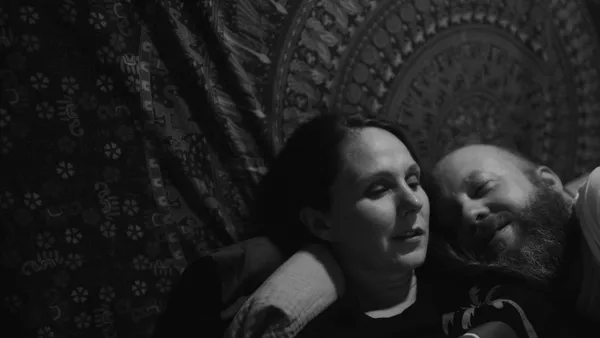 |
| Eilis Cahill and Steve Oram in Mind-Set Photo: courtesy of Bulldog Film Releasing |
When one becomes reasonably well known as a film critic, one finds oneself deluged daily with more films than there are waking hours. It’s impossible to watch them all and, sadly, it’s all too easy for good ones to sneak by under the radar. I might never have seen Mikey Murray’s Mind-Set except that last year I interviewed Steve Oram about another film, Cerebrum, and he mentioned that he had recently enjoyed working on an independent drama with a brilliant young director who he thought had a lot of potential. After our conversation he sent the film my way, and I instantly fell in love with it.
Astute, mature films which are also funny and yet retain the power to break one’s heart like this are few and far between. I talked it up as much as I could and was delighted to hear, in due course, that it was going to get a second, larger cinema run in the UK as well as being released on digital. Naturally I had to talk to Mikey, but where to begin with a film which has so much going on? One learns to look for the little things which tie it all together – in this case the little toys and knick-knacks which the couple on whom the film centres have scattered around their home. The elephants in the room.
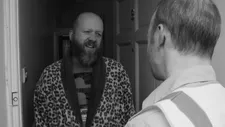 |
| Steve Oram in Mind-Set Photo: courtesy of Bulldog Film Releasing |
“I chose them because of the obvious metaphor of elephants in the room,” Mikey says. “I felt like I needed a device in the screenplay that would communicate something about their relationship visually. There are lots of things in the film that do, of course, but I thought that I just needed a sort of everyday object that they could interact with, which would say something about their relationship.
“You could probably guess that I'm in a long term relationship myself. We, between the two of us, have these little foibles. I had to create that level of interaction for the audience where they understood what type of relationship this was. I didn't directly lift anything specifically for my own relationship, but I was trying to create things that would be the same but different, if that makes sense.”
It does, I assure him. I loved the layered set dressing in the film in general. It provides a lot of backstory, explaining something of what these two very different people have meant to each other.
“Hazel Donnelly did the production design,” he says. “She came up with lots of ideas about the artworks and things that would be in the house and what they would do. One of the huge benefits was that we were using my own house for the film, so there was quite a lot of things that were already there, in a sense. But Hazel really picked out a lot of really interesting artefacts. I mean, the elephants were in the script, so they were already in there, but there's loads of nice things on the walls and things which I think builds the depth of the characters, these two artistic people who've had a life in the past that just adorns the walls, as it were.
“In developing the original concept, my approach to it was that I wanted to, in a way, sort of con the audience to think that they knew who these people were, through the stereotypical sort of stuff that we've seen in the past. And I've had actually people who've watched it who've said ‘I thought I knew what this film was going to be when I first started watching it, and I wasn't sure if I was going to like it. But then you turned everything on its head’ – which was purely by design. I wanted to make people go ‘Right, well, I know who these people are,’ and then as the film wears on, they go ‘Actually, I still kind of know who these people are, but they're not the people I thought they were.’ And I wanted to build that level of sympathy throughout.
“I wanted people to begin to empathise more and more with people with these two characters as the script wore on towards the end. So I did kind of want people to think that they were just a couple of annoying people initially, so that I could then turn that on its head.”
I mention that I think an awful lot of cinema relies on sexual attraction as shorthand for love, and yet many people, in the course of their lives will find themselves in situations where the love is still there but the sexual attraction isn't. That's a really interesting area to explore, and it's something which perhaps contributes, here, to what he said about misleading the audience.
“Yeah, I mean, that was certainly part of my thinking while I was writing. I wanted to have two characters who did deeply love each other. But I had to remove myself from the sexual attraction, as it were, with these two characters because otherwise, I think that helps to cement the love that they have for each other somehow. That's definitely my thinking with these two.”
In the course of the film, Eilis Cahill’s character, Lucy, will be tempted to have an affair. There's a whole lot of stuff built into our assumptions about affairs that Hollywood has taught us, that maybe doesn't map very well onto the real world, and this film does something very different. Did those pre existing expectations provide a lot to play with when developing the story?
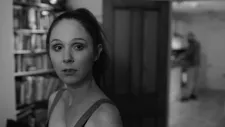 |
| Eilis Cahill in Mind-Set Photo: courtesy of Bulldog Film Releasing |
“Yeah, of course they did. As a writer, I'm constantly trying to play on what people expect. That's something that fascinates me. The love interest in the story is this incredibly good looking man who comes into her life and we expect her to want an affair with him, but then it just doesn't come out as we expect.
“ I think the film's core theme is that there is a lot more going on with these two people than we initially think or want to realise. I was trying to make people see these people on a surface level initially, because I do it when I'm sitting watching something. I mean, I've become a lot more savvy when I watch films now, but throughout my life, you start to watch something and the first thing you're trying to hang on to is whatever you're given.
“You are judging characters as soon as you see them and you're kind of saying ‘Right, well, do I empathise with this person? Do I like them, first and foremost? Is it a problem if I don't like them?’ Those kind of things. I think that when you do first meet people in life generally, it is a superficial exchange often, and it's not until you get to know people properly that you do start to see their foibles and any of these other elements. And then sometimes you get enough of an opening to understand that ‘Well, I initially didn't like that person, but now I have at least understood who they are. And therefore, I can have a more careful mind about how I think about that person. ‘
“I know that in my own life, I've probably been misunderstood quite often, early on. I have had friends who've said to me ‘I really didn't like you the first time I met you, Mikey, but I've since become to understand who you are.’ So I was playing on that, for sure. And I think particularly there's a moment at the party at the beginning, where Lucy's work colleague says ‘I did warn you,’ to her friend about Paul and the way that he is. There is that line in there suggesting like, this guy's a bit of an oddball and he's going to say all the wrong things. But she doesn't understand them on that deeper level so that's why she's using that line. “
We move on to discuss the way that the film is shot, and he astounds me with the revelation that it wasn’t originally shot in black and white. Usually one takes quite a different approach when shooting that way – few films look this good in both black and white and colour.
“I fully intended it to be a film that was in colour when I came up with the idea for it,” he says. “The strange thing about me is I'm not that person who's trying to make something black and white. It's never really been a thing that I do, but it just became more and more apparent as the film went on and as we worked through the edit that it needed to be in black and white. So that was the one thing that changed from the script, really, to the final output. I just think it represents what the film is about.
“I always knew that the film was kind of like a throwback to Sixties New Wave British filmmaking. It's clearly an update on that principle, but I'm hugely influenced by films like Billy Lier and the early John Schlesinger stuff and those kind of films. So as we started to get through it, I was like, ‘Yeah, I think that I probably just need to go even further with this.’ And we change the grade in post production to make it black and white.
“We had to be very careful when I made the decision. I spoke to my colourist, John Holmes, who's extremely talented, and I said, ‘I'm beginning to think this should be in black and white.’ And he immediately said, ‘I think that's a great idea.’ And I said ‘But we need to check that what we have will work,’ because we weren't in a position where we could reshoot anything. The film was shot in 11 days. It was a minuscule budget, so were basically out of money and it just had to be done right. The colour version looked lovely, but the black and white just really brings the film to be what I wanted it to be, I think, in my mind. John came up with this beautiful black and white grade, and once he did that, I was just like, ‘Yeah, this looks exactly as it should.’”
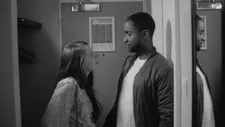 |
| Eilis Cahill and Peter Bankolé in Mind-Set Photo: courtesy of Bulldog Film Releasing |
I tell him that, for me, there's one shot which in the middle of the film which really sums up a lot of it. Lucy is looking out of the window at at roundabout and the traffic going around it – all these people moving around and perhaps going to more exciting places while she feels stuck. There's also a sense of circularity in her life.
“You probably hit the nail on the head with the way you've described it,” he says. “It was a shot that I had in my mind. I knew that building well, and I stood and looked out of that window and I thought that I wanted to use a shot like this. It is clearly a metaphor for what's going on in her life. And like any director, I'm constantly looking for the best visual metaphor for explaining a character without explaining it too much.
“I've got some major influences as a filmmaker. John Cassavetes is one who's a major influence over my work. His pacing is leisurely at times. I would say Hal Ashby is another big one. I think those influences are pretty clear in the final product, without necessarily being blatant. But pacing is important to me. I don't like things that are too frenetic in their pace. Particularly with this, which is character-based drama, we need time to figure these people out, so there's often scenes where the camera lingers.
“I'm not a huge fan of lingering on nothing. As a director, I think that there's this suggestion that if you leave the camera running for long enough, people will start to reinvest in the shot. But I think that in those situations, they need to be able to reinvest in something, and that something, for me, is usually character. For me as a viewer, when I watch a lingering shot in a film, I'm kind of like, ‘Well, why is the filmmaker giving me this time?’ And hopefully, what I'm doing is giving people time to consider these characters and their emotions.”
The film is full of charismatic actors and yet they are all kept in balance really well. That seems like a tremendous challenge for a director.
“I think it's in the casting,” he says. “It's who you choose for these roles and understanding that the actor isn't going to step over what's expected of them from the script. The script was very tight, actually. We did quite a lot of improvisation, but it was mostly at the end of scenes because were on such a short shooting schedule. I would say to the actors ‘Okay, at the end of the scene we'll have time for you to do a couple of extra things, but you need to get through the script. You must do the script stuff first, and then I will leave the camera running until the AD says ‘”Right, Mikey, we need to move on.”’
“There are some beautiful moments in the film that were captured through Steve or Eilis just riffing, if you like. I just think that all the actors that I managed to cast fully understood what the script needed. And that's the great thing about talent. It's the best thing about filmmaking for me, just watching the actors put their spin on your words as a writer.”
He originally got to know Steve, he says, after inviting him to come in and speak to some of the film students he teaches at the University of Lincoln, alongside a screening of Ben Wheatley’s Sightseers, and subsequently when Steve’s film Aaaaaaaah! played at the Indie Links Film Festival.
“I'm the director of that festival. It's a boutique festival, once a year. And I met Eilis because I was doing a bit of programming for Slam Dance one year, and I saw a feature film that she was in called Mad, which just pushed all my buttons. I thought it was fabulous piece of work. I got in touch with the filmmaker and he said, ‘Well, I'm in the US. I won't be able to make it to your festival. But Eilis, one of the actors, is currently living in the UK, so why don't you see if she can make it?’ So she came to the film festival as well, and ended up doing a panel with Steve.
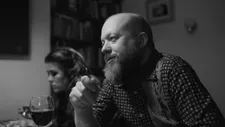 |
| Steve Oram in Mind-Set Photo: courtesy of Bulldog Film Releasing |
“We did an actors panel where we discussed how you get actors in your low budget films, and they said ‘Well, we really like it if we know someone's written something for us, if the writing is strong.” So I was one of the people who was listening, and I just went away and wrote a script for both of them. I sent it to them without telling them that I'd written it for them initially and just said ‘Could you read this and let me know what you think?’ And they both did and came back very positively saying ‘The script's really good.’ And I said ‘Fine. When are you available, Steve? Do you want to do this?’ He said yes. Eilis said yes. So I got the two actors I wanted right away.
“I knew there was going to be a great chemistry between the two of them, given that they both have a natural comedy, and I thought they were going to be perfect. And then I think I watched about 50 showreels of actors to get Peter. He was one of the ones whose showreel I really liked. I just thought he would be good for this role, so I got in touch. Coincidentally, he's with the same agency as Steve, so that also helped. So is Jason Isaacs. So I managed to get my script to Jason Isaacs through the connection of Steve's agent. He came back immediately and just said ‘Your script's amazing. Whatever I can do to help you, I will.’
“Julia Deakin again was another cameo. I had my eye on Julia because I found out that she was originally from Lincolnshire, and I thought that would be quite a good connection. I got in touch with her agent and just said ‘I've got this cameo part. I'd be wondering if Julia would be interested in it. I'd really like her to do a Lincolnshire accent. ‘ Apparently she'd never been asked in her entire career to do her Lincolnshire accent. So that was that. And then all the other actors were people that I knew personally. They are actors, but they're also friends.”
Where he goes from here is less clear, but there are a lot of exciting possibilities.
“I've got four feature scripts that are written, and a TV miniseries that I'm working on, but they're all at a fairly far on stage of development. So wherever the interest comes from, that will be what I'll do next.”





















